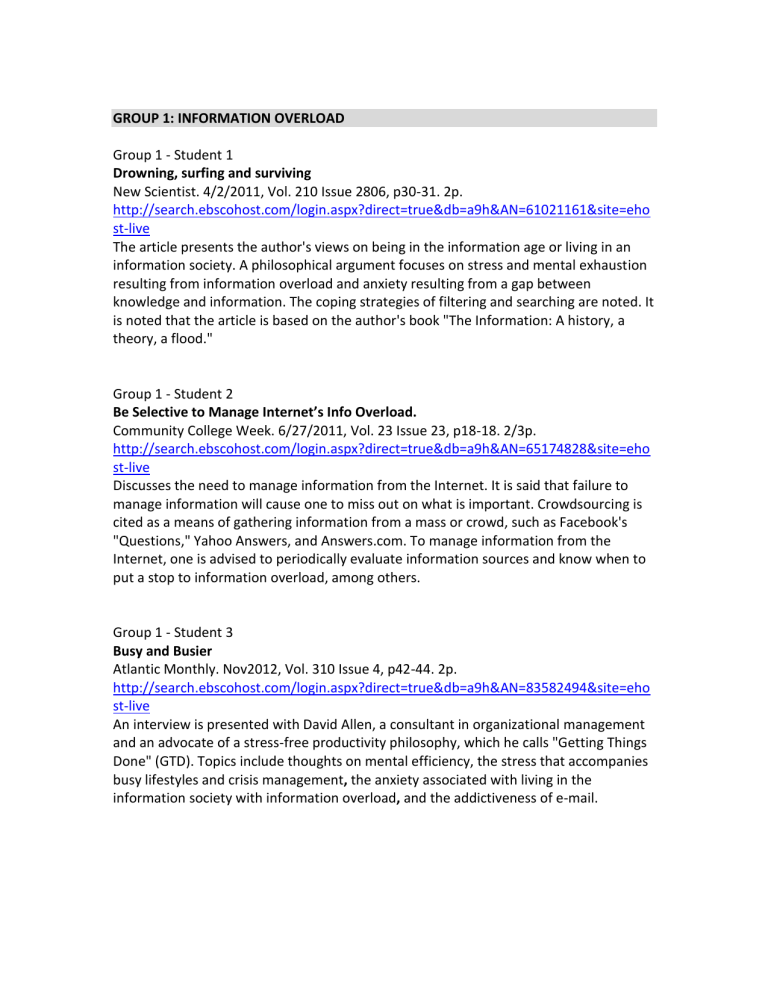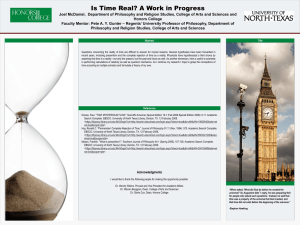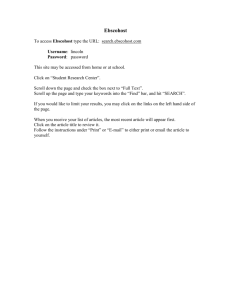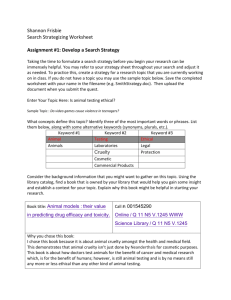HERE - WRI 10 - College Reading and Composition (Moberly)

GROUP 1: INFORMATION OVERLOAD
Group 1 - Student 1
Drowning, surfing and surviving
New Scientist. 4/2/2011, Vol. 210 Issue 2806, p30-31. 2p. http://search.ebscohost.com/login.aspx?direct=true&db=a9h&AN=61021161&site=eho st-live
The article presents the author's views on being in the information age or living in an information society. A philosophical argument focuses on stress and mental exhaustion resulting from information overload and anxiety resulting from a gap between knowledge and information. The coping strategies of filtering and searching are noted. It is noted that the article is based on the author's book "The Information: A history, a theory, a flood."
Group 1 - Student 2
Be Selective to Manage Internet’s Info Overload.
Community College Week. 6/27/2011, Vol. 23 Issue 23, p18-18. 2/3p. http://search.ebscohost.com/login.aspx?direct=true&db=a9h&AN=65174828&site=eho st-live
Discusses the need to manage information from the Internet. It is said that failure to manage information will cause one to miss out on what is important. Crowdsourcing is cited as a means of gathering information from a mass or crowd, such as Facebook's
"Questions," Yahoo Answers, and Answers.com. To manage information from the
Internet, one is advised to periodically evaluate information sources and know when to put a stop to information overload, among others.
Group 1 - Student 3
Busy and Busier
Atlantic Monthly. Nov2012, Vol. 310 Issue 4, p42-44. 2p. http://search.ebscohost.com/login.aspx?direct=true&db=a9h&AN=83582494&site=eho st-live
An interview is presented with David Allen, a consultant in organizational management and an advocate of a stress-free productivity philosophy, which he calls "Getting Things
Done" (GTD). Topics include thoughts on mental efficiency, the stress that accompanies busy lifestyles and crisis management, the anxiety associated with living in the information society with information overload, and the addictiveness of e-mail.
Group 1 – Student 4
News and the Overloaded Consumer: Factors Influencing Information Overload
Among News Consumers
CyberPsychology, Behavior & Social Networking. Nov2012, Vol. 15 Issue 11, p619-624.
6p. 3 Charts. http://search.ebscohost.com/login.aspx?direct=true&db=a9h&AN=83356294&site=eho st-live
This study explores novel areas of news surplus and overload, empirically examining factors associated with the degree of perceived overload across a broad spectrum of news delivery platforms. The findings reveal that the majority of today's news consumers feel overloaded with the amount of news they are confronted with
GROUP 2: PLAGIARISM IN THE DIGITAL AGE
Group 2 – Student 1
Rethinking Plagiarism in the Digital Age
Journal of Adolescent & Adult Literacy. Sep2012, Vol. 56 Issue 1, p35-44. 10p. 2 Charts. http://search.ebscohost.com/login.aspx?direct=true&db=a9h&AN=79862807&site=eho st-live
The article discusses plagiarism in higher education, with particular focus given to definitions of plagiarism, reasons students choose to plagiarize, and ways of preventing plagiarism. The influence of the internet and the collaborative nature of online culture on plagiarism is examined, and the author's assertion that instructors must explicitly define plagiarism and actively teach students how to avoid is explored. Reasons student plagiarize including lack of engagement with or interest in material and pressure to gain high grades are also commented on.
Group 2 – Student 2
Plagiarism and Other Sins Seem Rife in Science Journals, a Digital Sleuth Finds
Chronicle of Higher Education. 2/1/2008, Vol. 54 Issue 21, pA9-A9. 1/3p. http://search.ebscohost.com/login.aspx?direct=true&db=a9h&AN=30004980&site=eho st-live
The article reports on research suggesting the commonality of plagiarism and other corrupt publishing practices within scientific academic journals. The auditing software eTBLAST designed and used by research scientist Mounir Errami is described, highlighting its evaluation of articles published through the Internet medical research database Medline. Comments are given evaluating the results, suggesting that over
70,000 articles were "suspiciously similar" in content and format. Further commentary into the publication and self-disciplining behavior of the scientific community is also provided.
Group 2 – Student 3
Is Academic Honesty an Antiquated Ideal?
Star-Ledger (N.J.), Oct. 7, 2012, p. 1. http://blog.nj.com/perspective/2012/10/qa_is_academic_honesty_an_anti.html
Interview with Donald L. McCabe, Rutgers University who has studied student cheating for more than 20 years.
Group 2 – Student 4 (two short, related articles)
Unconscious Plagiarism
Chronicle of Higher Education. 6/20/2011. http://chronicle.com/article/Unconscious-Plagiarism/127928/
Blog post points out the nuances of “accidentally plagiarizing”. The comments are as valuable as the post.
Boston U. Panel Finds Plagiarism by Dr. King
New York Times, Late Edition (East Coast) [New York, N.Y] 11 Oct 1991: A.15. http://search.proquest.com/docview/428251181?accountid=14515
"There is no question," the committee said in a report to the university's provost, "but that Dr. King plagiarized in the dissertation by appropriating material from sources not explicitly credited in notes, or mistakenly credited, or credited generally and at some distance in the text from a close paraphrase or verbatim quotation."
GROUP 3: RESEARCH BIAS/MISINFORMATION
Group 3 – Student 1
The SkepDoc: Why We Can’t Trust Science Reporting
Skeptic. 2013, Vol. 18 Issue 2, p4-5. 2p. http://search.ebscohost.com/login.aspx?direct=true&db=a9h&AN=88429286&site=eho st-live
The article presents the author's views on the inconsistencies in scientific research which reportedly drives people to embrace quack medicine. She offers an example of how the changes in the findings of the physiological effects of a certain food would make people feel deceived. She comments that science is flawed, however it is foolish to embrace quackery which is more flawed. She also offers several factors that leads to inaccuracies in research findings which include researcher bias.
Group 3 – Student 2
Why Smart People Believe Stupid Things
Institute of Public Affairs Review. May2008, Vol. 60 Issue 2, p42-44. http://search.ebscohost.com/login.aspx?direct=true&db=a9h&AN=32080501&site=eho st-live
This article is a review of three books that all deal with “weird history” or the human capacity to believe in things that are fraudulent or simply unbelievable. Mentions the importance of using information to argue for sensible policies and ideas.
Group 3 – Student 3 (two short, related articles)
Desperate Parents Spark Search for New Treatment
Science 5 October 2001: Vol. 294 no. 5540 p. 37 http://dx.doi.org/10.1126/science.294.5540.37
Describes how a 1998 interview on Dateline NBC sparked a deluge of parents requesting an unproven autism treatment for their children. Subsequent studies and clinical trials on the use of the drug secretin yielded no support for the use of this medication to treat autism.
Stalled Trial for Autism Highlights Dilemma of Alternative Treatments
Science 18 July 2008: Vol. 321 no. 5887 p. 326 http://dx.doi.org/10.1126/science.321.5887.326
This article discusses the tension between physicians/parents and medical researchers to test chelation therapy as a plausible cure for autism. Researchers view the treatment as an “unethical experiment in voodoo medicine.”
Group 3 – Student 4
Desperate Remedies
Chapter from: Thompson, Damian. Counterknowledge: How We Surrendered to
Conspiracy Theories, Quack Medicine, Bogus Science and Fake History. New York: W.W.
Norton, 2008. http://trailproject.weebly.com/uploads/8/9/0/4/890410/thompson_damian_desperate
_remedies.pdf
Discusses quack medicine, CAM (complimentary alternative medicine) and the potential ramifications for health and well-being.
GROUP 4: ETHICAL USE OF INFORMATION
Group 4 – Student 1
Lost in the clouds
New Scientist. 3/30/2013, Vol. 216 Issue 2910, p35-37. 3p. http://search.ebscohost.com/login.aspx?direct=true&db=a9h&AN=86555715&site=eho st-live
The article discusses the increasing use of cloud computing for online data storage, focusing on data security, privacy, and ownership issues. It is noted that many average computer users are not even aware that their data from services such as email, digital media and electronic book content, and online social networks is stored on the cloud.
Topics include copyright of cloud data, the development of personal data deposit boxes, and the inclusion of cloud geography in computer interfaces.
Group 4 – Student 2
Returns of the Living Dead
Newsweek Global. 12/20/2013, Vol. 161 Issue 46, p1-7. 7p. http://search.ebscohost.com/login.aspx?direct=true&db=a9h&AN=93345848&site=eho st-live
The article discusses efforts by the U.S. Congress and the U.S. Internal Revenue Service
(IRS) to prevent fraudulent tax returns, with a focus on public access to death records through the Social Security Death Index. Raises awareness about public access to information.
Group 4 – Student 3
Contractor Admits to Leaks
Wall Street Journal. 6/10/2013. http://search.proquest.com/docview/1365975295?accountid=14515
Gives background information on the Edward Snowden case and the debate in Congress over national security and civil liberties.
Group 4 – Student 4 (two short, related articles)
Whistle-blower Snowden is tech person of year
USA Today. 12/30/2013. http://search.ebscohost.com/login.aspx?direct=true&db=a9h&AN=J0E184819337113&s ite=ehost-live
This article makes the case that Edward Snowden should be thanked for exposing NSA surveillance programs.
Edward Snowden Is No Hero
The New Yorker. 6/10/2013 http://www.newyorker.com/online/blogs/comment/2013/06/edward-snowden-nsaleaker-is-no-hero.html
Argues that Edward Snowden is a “grandiose narcissist who deserves to be in prison.”
GROUP 5: COPYRIGHT IN THE DIGITAL AGE
Group 5 – Student 1 ( two short, related articles)
The Perils of Copy Protection
Scientific American. Aug2011, Vol. 305 Issue 2, p36-37. 2p. 1 Color Photograph. http://search.ebscohost.com/login.aspx?direct=true&db=a9h&AN=62903123&site=eh ost-live
The article discusses how copyright protection used by some technical companies can have a negative impact on the sales of their products. The author argues that copyright does not promote product sales or stop online pirating, but instead creates inconvenience for honest users. An example is provided of a test he conducted that examined sales after one year of making paper and free electronic copies of his computer book available. Also discussed are actions taken by the music industry to end copyright protection.
The Lyrics Site That the Music Biz Hates
Rolling Stone. 1/16/2014, Issue 1200, p20-20. 2/3p. http://search.ebscohost.com/login.aspx?direct=true&db=a9h&AN=93528829&site=eho st-live
The article discusses accusations of copyright infringement against the hip-hop lyrics website Rap Genius by the U.S. National Music Publishers' Association (NMPA) as of
January 2014. Yale graduate co-founders Ilan Zechory, Mahbod Moghadam, and Tom
Lehman failed to license any material on their website, stating that their work falls under "fair use" in response to the takedown notices received from the NMPA.
Group 5 – Student 2
In India, Academics Defend Photocopying of Textbooks for Course Packs
Chronicle of Higher Education. 7/19/2013, Vol. 59 Issue 42, pA15-A15. 2/3p. http://search.ebscohost.com/login.aspx?direct=true&db=a9h&AN=89166725&site=eho st-live
The article discusses a lawsuit against the University of Delhi and Rameshwari
Photocopy Services in New Delhi, India filed by academic publishers Cambridge
University Press, Oxford University Press, and Taylor and Francis, who claim course packs created for university students violate copyrights. According to professors and students in India, the practice of photocopying course materials is legal and necessary in developing countries where students cannot afford to purchase textbooks.
Group 5 – Student 3 (two short, related articles)
What’s the Point with Pinterest?
Intellectual Property Litigation. Fall2012/Winter2013, Vol. 24 Issue 1, p12-17. 6p. http://search.ebscohost.com/login.aspx?direct=true&db=a9h&AN=90357061&site=eho st-live
The article focuses on Pinterest and how it operates. It refers to Pinterest as the newest social-media prodigy and the third most popular social-media behind Facebook and
Twitter where users can pin anything available on the web. It notes that since users direct Pinterest to copy images, they become liable for copyright infringement. It suggests pinning only one's own pictures or pictures the author has given permission to pin to avoid copyright problems.
What Should Social-Media Sites Do About Syria’s Savage War Videos?
Time. 5/27/2013, Vol. 181 Issue 20, p42. 1p. http://search.ebscohost.com/login.aspx?direct=true&db=a9h&AN=87708479&site=eho st-live
The article discusses the policies of several social media websites such as the YouTube video service and Facebook in regards to the posting of graphic videos which depict scenes from a war in Syria in 2013, including information on a video which depicts rebel commander Khalid al-Hamad allegedly desecrating the body of a Syrian soldier.
Copyright infringement is mentioned, along with cannibalism and the monitoring of social media content. Videos of beheadings in Mexico are also mentioned.
Group 5 – Student 4
Respray Your Reality
New Scientist. 5/19/2012, Issue 2865, p46-49. 4p. http://search.ebscohost.com/login.aspx?direct=true&db=a9h&AN=75382723&site=eho st-live
The article looks at the concept of digital graffiti, messages and images created by location-tracking smartphone applications to tag buildings, objects, and people as part of online social networks. The development of augmented reality (AR) devices to view digital graffiti is discussed, as well as AR software that allows users to add digital content to locations. Various issues posed by digital graffiti are explored, including copyright violation, freedom of expression, and privacy.



